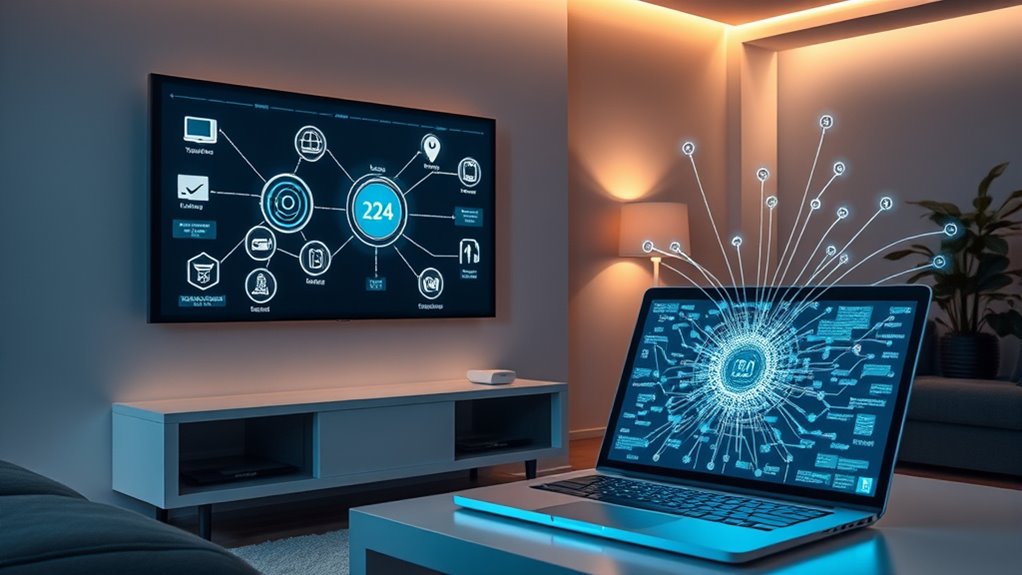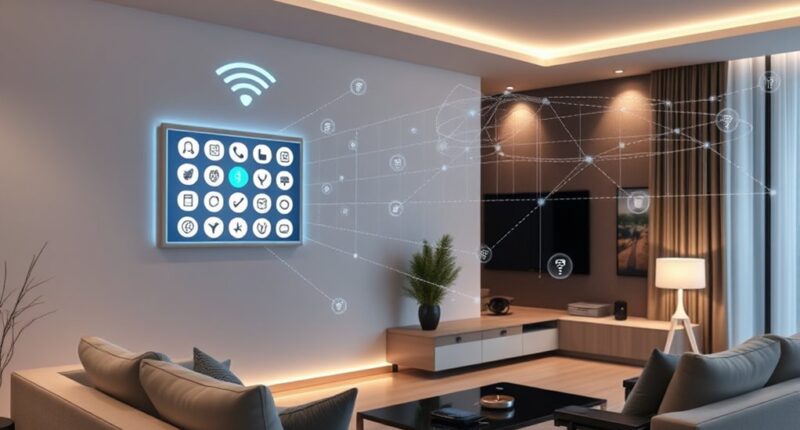Smart home devices collect a wide range of personal data, including your voice commands, audio and video recordings, location, contacts, browsing activity, and even health information. These devices often build detailed profiles of your habits and preferences, sometimes sharing data with third parties without your explicit consent. Many users worry about privacy breaches or unauthorized access. If you want to understand exactly what data is being mapped and how your privacy might be affected, there’s more to discover.
Key Takeaways
- Major devices like Amazon Alexa and Google Home collect dozens of data points, including location, contacts, browsing history, and audio recordings.
- Smaller devices such as Keurig machines gather fewer data points but often share data across third-party networks.
- Data collected is used to build detailed profiles of user habits, preferences, health, and behavioral patterns.
- Extensive passive monitoring and voice commands enable continuous data collection, raising privacy and security concerns.
- Collected data is frequently shared with third parties for profiling and targeted advertising without explicit user consent.

Have you ever wondered what your smart home devices know about you? If so, you’re not alone. These devices gather a staggering amount of data, often more than you might imagine. For instance, Amazon Alexa collects around 28 distinct data points per user profile. This includes device IDs, your exact location, contacts, and even health-related information. All of this data isn’t just stored; it’s used to build a detailed profile of your habits and preferences. Google Home isn’t far behind, collecting about 22 data points such as your addresses, photos, videos, browsing activity, and search history, all linked directly to your user profile. Even smaller devices like Keurig coffee machines keep tabs on you, collecting eight data points and linking your data across third-party networks—double what many popular smart devices gather.
Most smart home applications track users in multiple ways, with about one in ten doing so, which profoundly raises privacy concerns. Major tech companies dominate this landscape, consolidating diverse personal data sets that are tied directly to individual users. This raises a vital question: how much do you really know about what’s being collected and how it’s used? These practices involve collecting extensive data points, including sensitive health and behavioral information, which amplifies the privacy risks.
Most smart home apps track users in multiple ways, raising significant privacy concerns about data collection and use.
Many consumers share worries about their privacy. About 80% of U.S. users express concerns related to data security and privacy when it comes to their smart home devices. The fear of data leaks is prevalent, with 63% worried about third-party access or utility companies gaining unauthorized access. As the number of connected devices in homes increases, concerns only grow—75% of broadband households remain anxious about protecting their personal data. Despite these fears, only 21% of Americans feel completely unconcerned about privacy or security, and a significant 65% refuse to use smart devices that collect personal data, even if they offered insurance discounts.
Smart home adoption is on the rise. Voice-controlled devices now feature in half of all U.S. households, and smart TVs are present in 57%. Smart lighting and appliances are also becoming more common, with many integrating into kitchens and living spaces. Security devices like smart locks and sensors are steadily gaining popularity. AI plays an essential role in these homes, enhancing security through movement analysis, personalizing automation based on habits, and optimizing energy use. It even supports remote health monitoring, providing emergency alerts and health guidance.
All these devices collect a wide array of data—location, contacts, browsing history, audio and video, health info, and behavioral patterns. Sensitive data are linked to individual profiles, increasing the risk if they’re compromised. They continuously monitor your environment through passive sensors and voice commands, often using advanced AI techniques like natural language processing. Sadly, much of this data isn’t just used for device functioning; it’s also employed for profiling and targeted advertising, often shared with third parties without your explicit knowledge. As your smart home becomes smarter, it’s essential to understand just how much of your life is being mapped and stored.
Frequently Asked Questions
How Can I Identify Hidden Data Collection in Smart Home Devices?
You can identify hidden data collection by reviewing app permissions carefully and understanding what data they access. Keep an eye on unusual activity, like background data transmission or security vulnerabilities in your devices. Regularly update firmware and software to patch security flaws. Research privacy policies, even if they’re hard to find, and be cautious of third-party integrations or licensing that obscure data handling. Staying informed helps you spot and limit hidden data collection.
Are There Legal Protections for Smart Home Privacy?
Ever wonder if your privacy is protected? Yes, current US state laws offer protections for smart home data, granting you rights like access, correction, and opting out of data sales. These laws also require companies to be transparent and implement security measures. But, are all devices equally protected? Not necessarily—laws vary by state, and compliance depends on how well providers follow these regulations. Stay informed to safeguard your smart home privacy effectively.
Can Smart Home Data Be Hacked or Stolen?
Yes, your smart home data can be hacked or stolen. Cybercriminals frequently target vulnerabilities in devices like smart TVs, locks, and cameras, exploiting outdated software or weak security protocols. They use methods such as malware, unauthorized remote access, or DDoS attacks. To protect your data, you should keep devices updated, enable strong authentication, and isolate smart devices on separate networks, reducing the risk of intrusion.
What Are the Best Practices for Securing Smart Home Devices?
To secure your smart home devices, you should create a separate Wi-Fi network just for them, using a strong, unique password. Always keep your device firmware and software updated, disable unnecessary features, and enable multi-factor authentication where possible. Physically secure devices, use lock screens, and regularly monitor your network for unusual activity. Educate everyone in your home about security best practices to prevent accidental breaches.
How Does Smart Home Data Sharing Impact My Privacy Rights?
Your privacy rights are impacted when smart home devices share your data without full transparency or control. Sharing sensitive info with third parties can invade your personal space and increase the risk of data breaches. Limited control over who accesses your data worsens this. To protect yourself, actively review privacy settings, understand data-sharing policies, and ask manufacturers about data handling practices before installing devices.
Conclusion
As you navigate your smart home, remember that every device collects data—some more than you realize. Did you know that smart speakers can record up to 43% of your daily conversations? Staying aware of these data points helps you protect your privacy. Take control by reviewing device permissions and understanding what’s being shared. Protecting your personal info isn’t just smart—it’s essential in this connected world.









